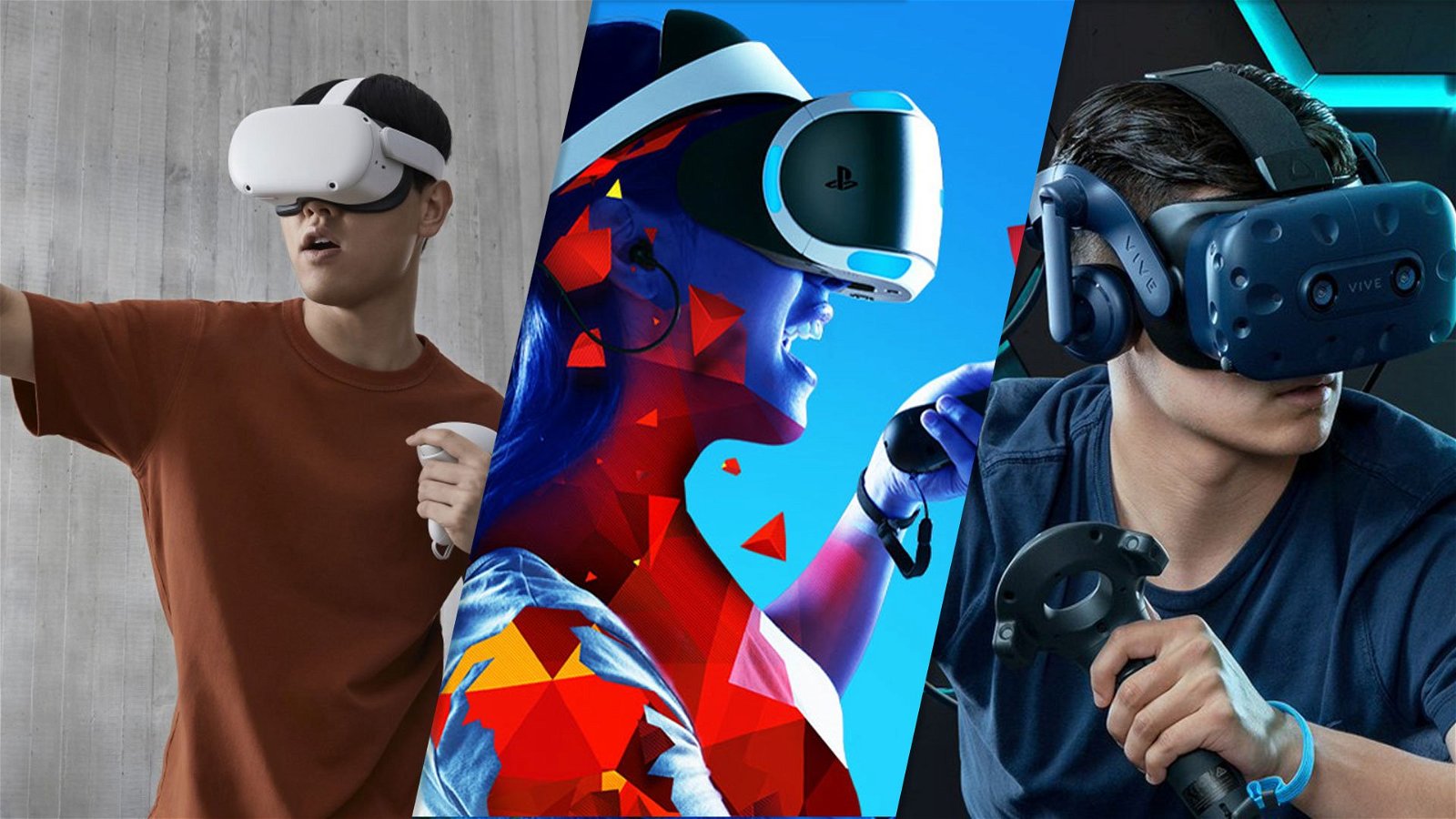Note: This feature is part of a series to inform readers about Virtual Reality (VR) content, ecosystem and concepts. You can read our previous entry here.
Cost, content and space.
These are the biggest barriers for consumers looking to join VR in 2021. The bar for VR tech was raised, but it also became easier for anyone to reach. To simply put it: things have drastically changed for the better since VR exploded in 2016. As the virtual reality market gained footing, observers slowly became consumers.
But as I previously wrote, VR made a wrong impression when it hit store shelves for the first time, touting itself as a highly premium gaming experience. It then became inaccessible to everyone excited about trying VR. Adding to the push backs were overhead PC costs and room-scale sensors. These complications were enough to push back buyers. So much that VR still comes to mind as a costly, risky and somewhat convoluted investment.
Now imagine those barriers gone. Actually, you don’t really have to.
This lengthy, but thorough guide aims to tackle as many uncertainties for VR as possible. All to provide you with an informed spending decision on VR gaming and entertainment.
I break VR’s biggest barrier down with two kinds of numbers: the amount of money spent and headsets to pick from.
Picking out a VR headset isn’t as complicated as it seems. Less than a handful of manufacturers come to mind: Oculus, HTC, Steam, PSVR and Windows Mixed Reality (which branches out to third-party brands). Given Oculus’ role and presence in consumer VR, we start our guide here. I mainly identify the variety and pricing for VR headsets. Subjectively, overhead costs should be considered for apps, games and other accessories you want to include after.

Going with the mainstream (Oculus Quest 2)
Headsets like the Oculus Quest 2 broke the biggest barrier on price. Its value starts at:
It’s worth noting the 64 GB model priced at $329 CAD was phased out of stores earlier this year.
As per my 10/10 review, it meets consumer expectations for affordability, price and quality. Nothing more and nothing less when matched with other competing headsets.
In 2016, the original Oculus Rift CV1 & Touch packed an expensive $1130 CAD price tag that didn’t even cover any overhead costs. Players required a high-powered PC to also use the very first Oculus Rift headset & Touch. Making it easier were the all-in-one features of the Quest 2. It packs its own mobile processor, which lets users play full VR experiences without a PC.
In other words, the first Oculus Quest and Quest 2 proved VR didn’t need a PC anymore. A game-changing update came in 2020, allowing Quest and Quest 2 owners to connect with computers. In other words, the Quest 2 finds plenty of value as a standalone and traditional PCVR headset.
Ironically, it’s also the cheapest headset packing VR’s most advanced features others still lack. Today, sensors are a thing of the past. The Quest 2 (and today’s VR headsets) pack inside out tracking to read your movement. This includes being able to walk freely in your room and world in real-time. Room-scale tracking also saves buyers much more in the long run.
Sensors, cables and a PC aren’t required to achieve that same experience. This makes the Quest 2 the most viable option and gateway into Virtual Reality. More importantly, Quest 2 is the only other headset to feature hand tracking and playable VR games without controllers.
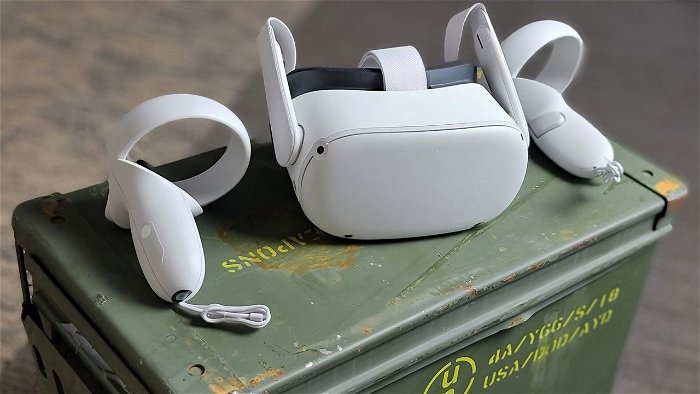
“But why not save and buy the original Quest in 2021?”
It’s easy for me to recommend the first Oculus Quest from 2019. Sure, it comes at a lower cost as an older model. But I shy away from the first Quest due to limited software support. The Quest 2 is a considerable upgrade over the first. Higher battery, frame rates and comfort come to mind.
The original Quest doesn’t have as many experimental features as Quest 2. These updates bring higher frame rates, visual quality changes and even some cutting-edge features Facebook says will help bring AR forward. Quest 1 users are a step behind with this support. Newer games developed by Oculus are also being pushed for Quest 2 exclusivity. Purchasing the Quest 1 saves more costs, but has a much shorter pipeline for software in the long run than Quest 2.
Clearly, it’s hard to escape the Quest 2’s shadow. As the all-in-one features come under the $400 CAD mark (128GB model). This brings us to its main competitor: HTC Vive. The company held its footing in 2016, starting with the first HTC Vive headset. It also gained a strong lead by showcasing a premium, high-quality level for VR gaming on computers. More importantly, this PCVR-only direction from Oculus and HTC became a part of the issue. Giving consumers a passive take on technology until it’s attainable and affordable.
Yes: Most PCVR options are still expensive.
To define PCVR: Abbreviation for computer-based virtual reality. It’s any headset that functions with a gaming PC, VR-ready computer or any custom high-spec unit. Always directly connected with an HDMI cable to the GPU, unless apps are wirelessly streamed from the PC to headset.
Gamers already living with high-end PCs might have their costs checked-off over time. This opens the guide up for PCVR options. These higher-end VR headsets take advantage of PC hardware. The GPU, higher memory and processing power fuel larger experiences beyond the Quest 2 (more on that later). Many of these experiences can wrap PCVR users with realism. So much that a high-end PC can render next-gen level worlds and widen the scale of games. Lone Echo, Stormland, Skyrim VR and Half-Life: Alyx are among some of the killer apps that can only run from a PC.
It’s worth noting HTC Vive is still reserved for those not looking for an alternative to Oculus. For some reason even a VR editor can’t explain, users can still spend over $1000 for an HTC Vive with controllers. Sadly, this asking price is enough to hold users back. At almost triple the price of a Quest 2, users should consider the level of content they want out of their headsets.

This guide also stresses every headset (excluding PlayStation) can access PCVR. Given users already have a PC that meets minimum specifications.
Meet the VIVEs (HTC’s VR line)
To simplify HTC Vive’s menu, their collection is broken into three lines:
Like choosing a vehicle, HTC’s VR headsets have these classes. No tires or engines included. Not even a half tank of gas.
The Cosmos line is HTC’s cheapest PCVR option.
Supposedly.
The basic HTC Vive Cosmos starts at $1099 CAD. Fortunately, Cosmos is also kitted with 2021 standards like inside-out tracking and ergonomic hand controls. PC owners only have to buy the Cosmos without much overhead.
Things get a bit complicated with the HTC Vive Cosmos Elite at $1399 CAD. It’s the premium version of the cheapest headset. HTC questionably ditches the inside-out tracking. It uses older and traditional sensors to accurately track players moving around a room. This does offer a more precise experience for PCVR. But at the cost of added hardware and dated controllers. As per my review of the HTC Vive Cosmos Elite, the controllers have barely changed since 2016. But objectively, others might not find any issues with having this mechanical, wand-like design.

It’s also worth noting the Cosmos line features modular face plates, letting users change up tracking or other compatible features. Other overhead costs include extra base stations (tracking sensors) or a face plate to simulate lips and expressions in certain experiences.
“But wait, there’s more!”
HTC caters to the high rollers in the Pro line. Specifically, it’s used by enthusiasts and content creators “that require immersive experience.” The HTC Vive Pro starts at $1459 CAD. It sports a high quality resolution and everything else as the Cosmos Elite. Controllers, cables, trackers and all.
The upcoming HTC Vive Pro 2 reportedly adds a 5K resolution, wider field of view for landscapes and eye comfort. It also shoots past the price tag at $1849 CAD (debatably, the cost of a custom PC).
Currently, the most expensive of the bunch is its HTC Vive Pro Eye at $1899 CAD. It comes with the same features as the base Pro. Except it sports an experimental eye-tracking feature that applies to game characters and “lifelike interactions.” This guide doesn’t harbour any judgment on those looking for the highest price for VR.
There’s even more.
The HTC Vive Focus 3 is an all-in-one VR headset. HTC’s latest 2021 headset packs inside-out tracking, new touch controllers, a 5K display and is PCVR compatible. Like the Oculus Quest 2, it doesn’t rely on a PC to work. This is also HTC’s only available headset that sports its own hardware and software. But the Focus 3 is geared towards industry and businesses. To introduce virtual meetings, offer precise training programs, CAD engineer tools or interactive museums. HTC’s own answer to the Quest 2 comes at about $1750 CAD.
Yes, that’s about the price of four Oculus Quest 2 headsets without tax.
Letting off some Steam (The Valve Index)
Game publisher Valve (Half-Life, Counter-Strike, Left 4 Dead) and their interest in VR came with a passive-competitive edge. They clearly wanted to go into VR with their own sense of control. Both their VR apps and hardware reflect this level of research. Particularly by observing the industry in 2016, as Oculus and HTC duked it out with their early PCVR headsets.
In 2019, the Valve Index headset would answer the call for an alternative platform (more on this as we talk ecosystems) that worked naturally with most VR games.
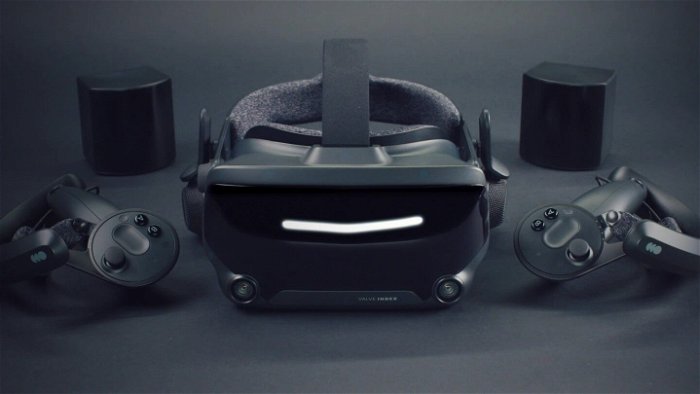
The full package also sets users back $1319 CAD, without that high-end PCVR overhead cost.
So it’s no question that the Valve Index headset would work best as a highly premium headset that only works with PCVR. It’s still very much a traditional headset that depends on a PC and sensors to work. But the Valve Index offers a razor-sharp tracking in rooms. Along with highly advanced finger-tracking controllers for added realism. The Index controllers also “stick” to VR players, free to let go and perform natural hand gestures.
Games like Half-Life: Alyx, Boneworks and other supporting experiences pull players in through finger sensing. But this feature isn’t a make-or-break. It’s worth noting the Valve Index isn’t exactly the most tailored for first time VR users. Those already with high-end PCs and PCVR setups get a smoother upgrade that Valve has geared the Index for. But this $1319 upgrade comes with nearly 2K resolutions, 144Hz refresh rates and a free copy of Half-Life: Alyx (again, VR’s darling child).
Debatably, it’s the smoothest true PCVR experience for price.
A VR station within a… PlayStation? (PSVR)
The PlayStation VR (PSVR) headset is a bit of an aging pick.
Think: a headset that can play PCVR titles without the PC.
Buyers might feel welcome by a $449 CAD price tag, which comes marginally higher than the Oculus Quest 2. This pricing has deflated since its launch in 2016 (the “birth” year of VR). It’s also worth noting this headset only works with the PS4 and PS5 consoles. This requirement pushes first-time consumers back, but makes it easier for existing gamers to join the VR fun. Unsurprisingly, it was easy for Sony to create this as an add-on gadget for PS4 owners and use the console’s horsepower. PSVR released in 2016, just in time as other competitors put their headsets on store shelves.
Flash forward to 2021, it’s a bit tougher to recommend the PSVR for being steps behind the latest headsets.

More importantly, the PSVR is a system stuck in time. But that doesn’t mean it’s the weakest link of the VR choices.
First time buyers get to see higher quality VR in the smoothest way. This comes with PlayStation holding a user’s hand through some pretty familiar steps. Using the PS4 system as usual. Holding the Dualshock 4 or a pair of PS Move controllers as usual. Once users get past the slightly complicated cable setup, it’s mostly smooth sailing. The headset itself is also impressively crafted, featuring a comfy “halo” strap around your head. A flip-up feature lets users eject out of VR to take a peek at the real world.
The PSVR also reflects Sony’s own ecosystem. Quality and content are strong through PlayStation’s focused direction. This headset packs a range of exclusive games. But surprisingly, it includes most of the same titles as PCVR. The catch is most of these games from other ecosystems take later to arrive on PlayStation VR. Impressively, Sony still continues to support the PSVR headset with a steady flow of games into 2021 and beyond.
It’s also harder to suggest the PSVR in 2021, ahead of an even newer model.
Like the Quest 2 and Valve Index, the next generation PSVR headset adds true VR touch controllers (including grips, joysticks, ergonomics and haptic feedback). It will also sport a higher resolution as future PSVR games start development with the PlayStation 5 console in mind. At the lower $449 price, the first PSVR can be a smooth entry point for new users. Only that it relies too much on the PS consoles and is considerably older.
This guide will cover more about the exclusives and ecosystem below.
Windows Mixed Reality & Third-Party options
Still reading?
You’ve probably noticed how the Oculus Quest 2 and HTC Vive Focus 3 are the only VR units that are standalone in nature.
The rest, including the Windows Mixed Reality (WMR) headsets still depend on a compatible PC. These VR-ready computers are the consoles which run higher-fidelity games at a big scale. The WMR platform isn’t any different from the other PCVR headsets I mentioned above.
Only that all kinds of manufacturers are open to creating WMR headsets.
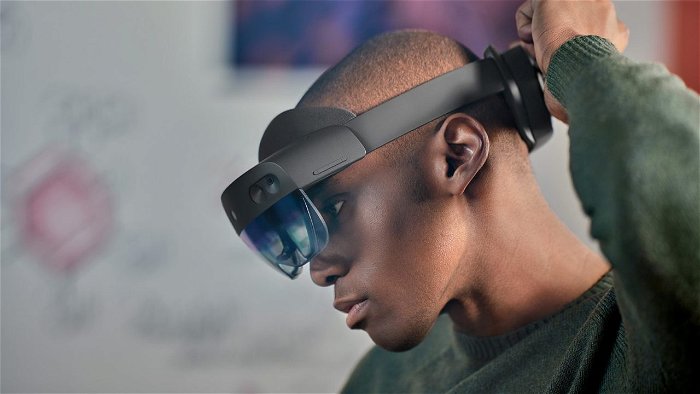
To put this clearly: Android OS to all phone companies is what Windows Mixed Reality can be to all tech brands.
Since 2016, WMR has become Windows’ and Microsoft’s answer for the competitive virtual reality market. They also cleverly named their platform “Mixed Reality” in the hopes of creating a space for VR and AR apps together. These headsets come in many third-party varieties. Here, VR buyers get the most freedom in choosing WMR headsets based on price and features. If they have the PC to back it up.
And yes: WMR headsets run on their own software and menus. But it can also be used exactly like any other PCVR headset. Even access other VR ecosystems to play almost every game. Here, this guide excludes WMR products like the Augmented Reality (AR) Microsoft HoloLens, which don’t bring users into VR. Such AR products are tailored for skilled trades, enterprise and architecture in specifically designed apps.
I can’t begin to tell you how many VR-based headsets have been manufactured from Acer, Samsung, HP, Lenovo and Dell. Headsets vary in price, offering easier VR access like the Acer WMR Headset at $250 CAD. Or the HP Reverb G2 priced over the $850 CAD mark. These familiar brands use the Windows Mixed Reality platform, which essentially adds a few more productive features. AR office meetings, projecting desktop apps and other exclusive work-based apps set WMR apart from the others.
Barrier 2: Content and Ecosystems
A new VR purchase in 2021 offers access to over five year’s worth of content and counting.
Even more if users dig before 2016. It’s safe to say that users can find their own favourite experiences to go back to. Like a simulated dream machine straight from science-fiction, VR offers something for everyone. This includes a movie theater that plays any media. A rock climbing gym. A shooting range and multiplayer battle royale. Meditation spaces. Even a space simulator. If you can imagine it, chances are there is a VR experience for it.
This library of games are shared and even unique across each VR ecosystem. I highly suggest you browse through the Oculus and SteamVR stores to see what’s included and exclusive.
There are three main ecosystems you’ll come across in VR:
- Oculus (Standalone & PCVR)
- SteamVR (PCVR only)
- PSVR (PS4 and PS5 only)
Each VR system works directly with each one. Only the Oculus Quest can access both its own ecosystem and SteamVR. All other PCVR and WMR headsets mainly work with SteamVR. The PSVR runs exclusively on its PS4 and PS5 ecosystem.
Oculus
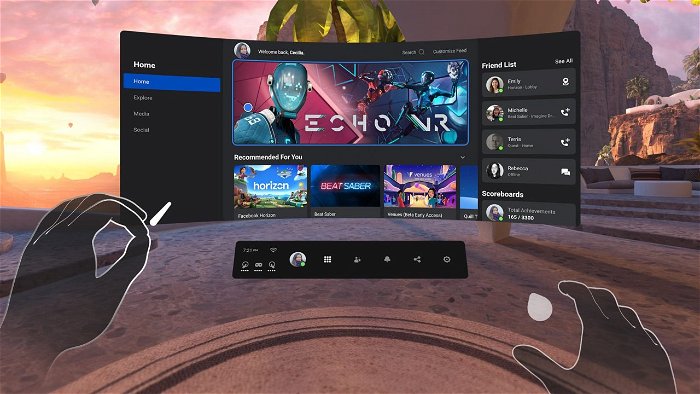
The OculusVR ecosystem existed as early as 2012. This created a footprint as the company was rolling out its first Development Kit for the Oculus Rift in 2013.
Since then, Oculus has gained a firm presence on PCVR and the Quest platform.
Unsurprisingly, this ecosystem is shown in the Oculus Store. Apps, games and exclusive Oculus software are distributed here. Users can find most PCVR apps sold by Oculus. Third-party titles and VR games made by major publishers only grow Oculus’ fully digital library. All Oculus Quest and older Rift devices are also connected to its ecosystem. Now a part of Facebook’s identity as it acquired Oculus in March 2014. This also means new VR users are required to have a Facebook account in order to access Oculus’ online services and updates.
This ecosystem has also put Oculus Studios as a major game publisher for VR. Like any game console, users can find a number of their exclusives only for Quest and PCVR. Of course, games for Quest 2 are fully wireless. Newer titles like The Climb 2 and Resident Evil 4 are fully wireless experiences only found on Quest 2.
As Oculus exclusives, these exclusives can’t be played or found across any other VR product.
You can check out all the standalone Quest and Quest 2 experiences here.
A major twist: the standalone Quest 2 also doubles as a PCVR headset. A 2020 update for Oculus Link enables Quest users to plug a USB-C cable and stream PCVR games through computers. The connection also offers seamless and nearly lag-free VR on powerful systems. This is also why the guide excludes the older 2019 Oculus Rift S headset; a PCVR only headset later replaced by the Quest 2. The Link feature opens up the Oculus ecosystem for bigger games the standalone Quest can’t run. Here, players can access PCVR exclusives like Lone Echo 2, Asgard’s Wrath, Rock Band VR, Quill and Stormland.
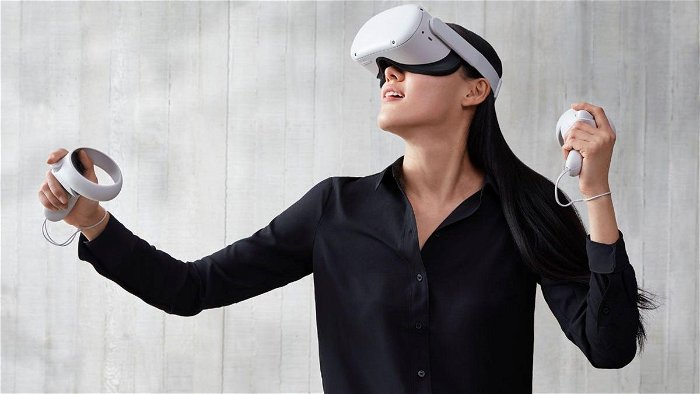
You can browse all of Oculus’ exclusive PCVR experiences here.
The bigger twist: Oculus users also get access to Valve’s SteamVR ecosystem.
This means Quest 2 owners can access almost every PCVR game released. It also lets users get PCVR games not found on the Oculus Store. In other words, not every PCVR game is distributed on the Oculus store. But they can be found alternatively on SteamVR. For Quest 2 users, it’s the best of both worlds.
For example: the acclaimed science fiction PCVR shooter Half-Life: Alyx isn’t found on Oculus’ store. But it can still be played over SteamVR with the PC Steam application. Check accordingly over the three ecosystems for a game you want.
Being under the Oculus ecosystem with Quest 2 also enables a few exclusive perks. One includes cross-buy.
One purchase for a supported game means getting the PCVR version and Quest 2 version to play on-the-go. Titles like Vader Immortal, Phantom: Covert Ops and Robo Recall are a few Oculus exclusives that support this cross-buy feature. Another perk includes an automatic warranty tied to Facebook accounts for any hardware or software issues. The Oculus library also enables cloud-saving and games can carry over to any new headsets in the future.
The guide also acknowledges workarounds for non-Oculus users accessing their ecosystem. Popular open-source application Revive lets HTC VIVE or Valve Index users play exclusive Oculus games. But this leads to some hiccups in visual quality, controls and overall compatibility. In other words, there’s a way non-Oculus headsets can enjoy the publisher’s exclusives. But as told in a statement to UploadVR by Oculus in 2016, Revive is considered a hack and isn’t recommended.
SteamVR
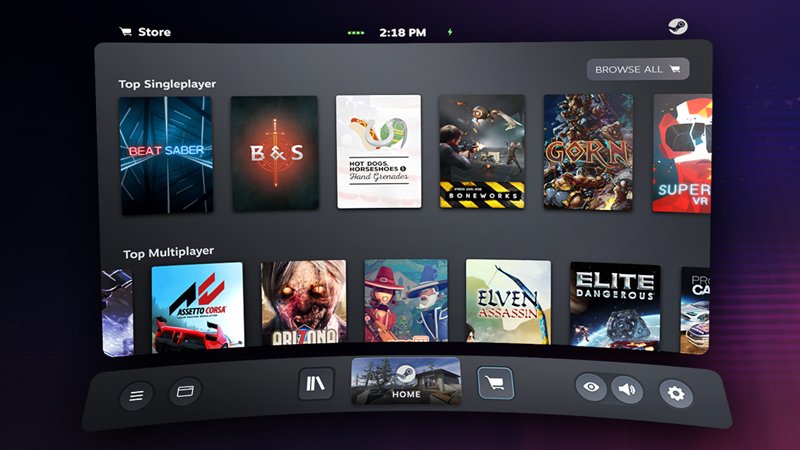
Valve Corporation didn’t just create their own VR headset. In April 2016, the developer decided to expand their existing Steam application into VR territory. Steam established itself as the go-to place to download and play PC games. SteamVR would follow the same model, letting almost every VR headset access PCVR games in one place.
Arguably, this ecosystem is also the biggest source for PCVR games. It’s also essential for using the HTC VIVE and WMR headsets, all SteamVR supported. SteamVR isn’t hard to access, as it can easily be installed as an add-on here. This lets PCVR users plug and play.
Simple as that.
As mentioned, SteamVR also supports the Oculus headsets. Universally, SteamVR was designed to naturally work with every type of PCVR headset. This automatically detects which VR headsets are connected. Then makes any kind of VR controller work with a game played over SteamVR. It’s worth noting that SteamVR offers the same ecosystem as normal PC gaming. This includes two hour play and return policies. Cloud saving. Modding and Workshop support. Even growing a large PCVR library to use in one account. Steam also has a store page for buying the Valve Index and other accessories.
To stress: Half-Life: Alyx is only available on Steam and the SteamVR ecosystem. Be very careful with games being both available on the Oculus and Steam apps. Organize and select your purchases accordingly for shared titles like Budget Cuts 2, The Walking Dead: Saints & Sinners, SUPERHOT, Job Simulator or Sniper Elite VR.
You can browse the full SteamVR and PCVR library here.
PlayStation VR Store
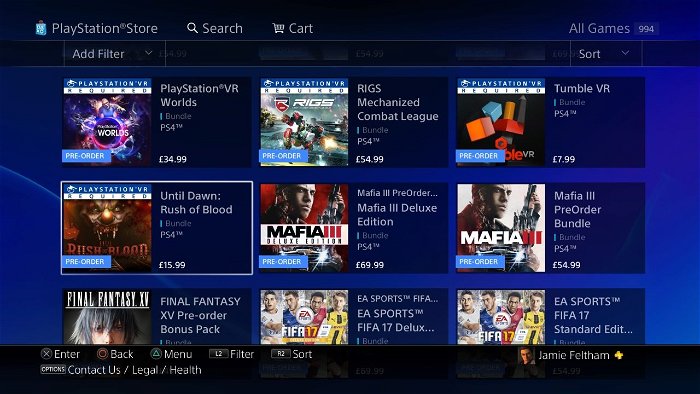
The PSVR ecosystem is by far the simplest and unique out of the three.
Since the PlayStationVR is directly working with PS4 or PS5 systems, they share the same layout and store. Inside the PSVR headset, users simply navigate through their consoles. All PSVR games are also bought and downloaded through the traditional PlayStation Store. This unifies all VR games and appears in your own library.
As previously hinted at, the PSVR ecosystem is supported with third-party games also found on Oculus or SteamVR. There’s no surprise in finding games like Vader Immortal, Song of the Smoke, Sniper Elite or I Expect You to Die 2 on the PS4.
But PSVR also has their own exclusive games not found elsewhere. Fracked, Farpoint, Resident Evil 7, Until Dawn: Rush of Blood, Iron Man VR and the acclaimed Astro Bot: Rescue Mission are some of the games only on PSVR.
PlayStation’s exclusive content for PSVR goes deeper. Games including Resident Evil 7 and Hitman 3 have a special option to play in VR. But this can only be done with PSVR as an exclusive feature. Like Oculus, the PSVR ecosystem gives buyers value through these exclusives and perks. At the cost of a smaller library.
Unfortunately, the PSVR is also slower for new game releases.
Third party titles often release for Oculus or SteamVR first. Then developers would release those games later by porting them for PSVR. This process was seen in games like Vader Immortal, Budget Cuts and Zero Caliber which made PSVR owners wait a bit longer. PSVR’s ecosystem is a unique one through Sony’s recommitment in 2021. Its upcoming PSVR2 headset only creates more exclusives that are propelled by the PS5 console.
You can browse the full PSVR library here.
Barrier 3: Space
Surprisingly, room for VR is actually the largest reason for skeptics. It makes complete sense for houses to not have room for VR. This leads into a cartoon picture of destroying everything. No space. No VR.
But this barrier is also the easiest to manage of all three.
There’s a subjective and immediate level of control for your VR space. Moving a small table or chair could make all the difference. In other words, you only need to make enough space for arms-length. Simple as that.
The best way to find your bare minimum VR space:
- Pick a spot to stand in. Any spot.
- Hold out your arms.
- Spin around three times (four because you’re such a fun reader).
- If you didn’t knock anything over, this spot is VR-ready.
There’s actually a choice for walking around in your space or being stationary.
All VR games feature locomotion, a mechanic that lets players teleport or walk on the spot. This is done with the controller’s joystick, which also lets users turn artificially. Locomotion comes with a learning curve for motion sickness. But the practice lets VR users realize any arms-length space is plenty when stationary. There are a number of accessibility settings that also enable fully-seated experiences. This comes standard in nearly every VR game to date. Titles including Half-Life: Alyx also calibrated for height and comfort. In other words, all VR games can be fully seated experiences.

VR players also have ways to know their positions and not hit a wall. Another unspoken feature: VR users can set up virtual boundaries.
This exists as the following:
Oculus: The GUARDIAN system. The Quest 2’s cameras show users their real world spaces. Users point and spray their own wall around them. The wall automatically appears when a user’s head or hands are near the boundary. Furniture and other obstacles are also tracked. GUARDIAN also lets users check their floor boundaries and position by looking down. The game will disappear and activate AR mode when users go completely out of bounds. Players can also choose to recalibrate their positions anytime by holding the Oculus button.
SteamVR & WMR: The CHAPERONE system. This works exactly like Oculus’ GUARDIAN system. Setup is done through the initial SteamVR setup when a new headset is plugged in. Users can draw out their boundaries by guiding their controller around a space. A digital wall appears when players are nearing an edge. Users can access their quick menu settings to reset their view and positions.
Finding space is much easier for users already prepared. Those with measuring tape can test these official guidelines from Oculus and Valve:
- Recommended room scale space: 6.5 x 6.5 feet (2 by 2 metres) or more.
- Recommended room scale space: 6.5 x 5 feet (2 by 1.5 meters of free space.
- Maximum distance for VR sensors: 16 feet (5 meters).
These metrics are geared for extra prep. This guide still considers having an arms-length space as enough to play VR. Other tips to keep track of your position include standing on a small mat, tape or peeking down your headset’s nose gap.
Have fun!
VR can be as exciting and futuristic as one can expect. CGM’s own VR guide works as a one-stop manual for consumers thinking about their purchases. Each VR headset offers their own special perks, on top of an affordable VR experience starting with the Quest 2 and WMR headsets.
More importantly, each ecosystem offers a shared majority of VR games. This makes choosing a headset easier, through a budget and knowing their limits. Standalone headsets offer an instant pick-up-and-play experience. While opening the doors for higher PCVR experiences.
After reading, feel free to leave your thoughts or suggestions in a comment below for next year’s 2022-2023 VR guide.
Reviews and supplementary CGM links are provided to let users go deeper into the VR headset choices featured. Prices are laid out in Canadian MSRP.
